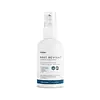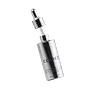What's inside
What's inside
 Key Ingredients
Key Ingredients

 Benefits
Benefits

 Concerns
Concerns

No concerns
 Ingredients Side-by-side
Ingredients Side-by-side

Water
Skin ConditioningGlycerin
HumectantButylene Glycol
HumectantDextran
Epilobium Angustifolium Flower/Leaf/Stem Extract
Skin ConditioningPalmitoyl Tetrapeptide-20 Amide
Acetyl Tetrapeptide-3
Skin ProtectingTrifolium Pratense Flower Extract
AstringentPolyacrylate Crosspolymer-6
Emulsion StabilisingPanthenol
Skin ConditioningPolygonum Multiflorum Root Extract
Skin ConditioningHydrolyzed Wheat Protein
Skin ConditioningPhenoxyethanol
PreservativeCaprylyl Glycol
EmollientEthylhexylglycerin
Skin ConditioningTocopheryl Acetate
AntioxidantPanax Ginseng Root Extract
EmollientAcetyl Tyrosine
Skin ConditioningSodium Metabisulfite
AntioxidantGlycine
BufferingLarix Europaea Wood Extract
HumectantZinc Chloride
AntimicrobialCamellia Sinensis Leaf Extract
AntimicrobialBiotin
AntiseborrhoeicCaffeine
Skin ConditioningTetrasodium Glutamate Diacetate
Water, Glycerin, Butylene Glycol, Dextran, Epilobium Angustifolium Flower/Leaf/Stem Extract, Palmitoyl Tetrapeptide-20 Amide, Acetyl Tetrapeptide-3, Trifolium Pratense Flower Extract, Polyacrylate Crosspolymer-6, Panthenol, Polygonum Multiflorum Root Extract, Hydrolyzed Wheat Protein, Phenoxyethanol, Caprylyl Glycol, Ethylhexylglycerin, Tocopheryl Acetate, Panax Ginseng Root Extract, Acetyl Tyrosine, Sodium Metabisulfite, Glycine, Larix Europaea Wood Extract, Zinc Chloride, Camellia Sinensis Leaf Extract, Biotin, Caffeine, Tetrasodium Glutamate Diacetate
Water
Skin ConditioningPropanediol
SolventButylene Glycol
HumectantGlycerin
HumectantAcetyl Tetrapeptide-3
Skin ProtectingBiotinoyl Tripeptide-1
Lactobacillus
Skin ConditioningSaccharomyces/Rice Ferment Filtrate
Skin ConditioningNicotiana Benthamiana Octapeptide-30 Sh-Oligopeptide-2
Skin ConditioningMentha Piperita Leaf Extract
Skin ConditioningBiotin
AntiseborrhoeicNicotiana Benthamiana Hexapeptide-40 Sh-Polypeptide-9
Nicotiana Benthamiana Hexapeptide-40 Sh-Polypeptide-86
Rosa Centifolia Flower Extract
AstringentPanthenol
Skin ConditioningTrifolium Pratense Flower Extract
AstringentZingiber Officinale Root Extract
MaskingMelia Azadirachta Leaf Extract
Skin ConditioningMelia Azadirachta Flower Extract
Skin ConditioningCoccinia Indica Fruit Extract
Skin ConditioningCorallina Officinalis Extract
Skin ConditioningLeuconostoc/Radish Root Ferment Filtrate
AntimicrobialDextran
Sodium Phytate
Parfum
MaskingCitric Acid
BufferingPotassium Sorbate
PreservativeEthylhexylglycerin
Skin ConditioningPhenoxyethanol
PreservativeLinalool
PerfumingWater, Propanediol, Butylene Glycol, Glycerin, Acetyl Tetrapeptide-3, Biotinoyl Tripeptide-1, Lactobacillus, Saccharomyces/Rice Ferment Filtrate, Nicotiana Benthamiana Octapeptide-30 Sh-Oligopeptide-2, Mentha Piperita Leaf Extract, Biotin, Nicotiana Benthamiana Hexapeptide-40 Sh-Polypeptide-9, Nicotiana Benthamiana Hexapeptide-40 Sh-Polypeptide-86, Rosa Centifolia Flower Extract, Panthenol, Trifolium Pratense Flower Extract, Zingiber Officinale Root Extract, Melia Azadirachta Leaf Extract, Melia Azadirachta Flower Extract, Coccinia Indica Fruit Extract, Corallina Officinalis Extract, Leuconostoc/Radish Root Ferment Filtrate, Dextran, Sodium Phytate, Parfum, Citric Acid, Potassium Sorbate, Ethylhexylglycerin, Phenoxyethanol, Linalool
Ingredients Explained
These ingredients are found in both products.
Ingredients higher up in an ingredient list are typically present in a larger amount.
This biometic peptide is designed to support hair growth.
According to a manufacturer, it stimulates hair growth by:
The manufacturer has found combining this ingredient with red clover extract (Capixyl) boosted benefits. Not only does it enforce the scalp's extracellular matrix, it also inhibits the enzyme that creates DHT, a hormone that leads to hair loss.
While this ingredient is promising, more research is still needed to confirm its full effectiveness.
Learn more about Acetyl Tetrapeptide-3Biotin is a B vitamin that is naturally produced by our bodies. It is also called Vitamin H.
Our bodies use biotin in the metabolism process. It also helps our bodies use enzymes and move nutrients around. A biotin deficiency can lead to brittle hair and nails.
More research is needed on applying biotin topically. However, taking biotin orally has been shown to help nourish the skin, hair, and nails. They play a role in forming skin-hydrating fatty acids.
Biotin is water-soluble. It can be found in foods such as fish, eggs, dairy, nuts, and meat. Vitamin H stands for "haar" and "haut". These are the German words for hair and skin.
Learn more about BiotinButylene Glycol (or BG) is used within cosmetic products for a few different reasons:
Overall, Butylene Glycol is a safe and well-rounded ingredient that works well with other ingredients.
Though this ingredient works well with most skin types, some people with sensitive skin may experience a reaction such as allergic rashes, closed comedones, or itchiness.
Learn more about Butylene GlycolDextran is a sugar (polysaccharide) with skin hydrating properties.
Fun fact: Louis Pasteur first discovered this ingredient as a microbial product in wine.
Ethylhexylglycerin (we can't pronounce this either) is commonly used as a preservative and skin softener. It is derived from glyceryl.
You might see Ethylhexylglycerin often paired with other preservatives such as phenoxyethanol. Ethylhexylglycerin has been found to increase the effectiveness of these other preservatives.
Glycerin is already naturally found in your skin. It helps moisturize and protect your skin.
A study from 2016 found glycerin to be more effective as a humectant than AHAs and hyaluronic acid.
As a humectant, it helps the skin stay hydrated by pulling moisture to your skin. The low molecular weight of glycerin allows it to pull moisture into the deeper layers of your skin.
Hydrated skin improves your skin barrier; Your skin barrier helps protect against irritants and bacteria.
Glycerin has also been found to have antimicrobial and antiviral properties. Due to these properties, glycerin is often used in wound and burn treatments.
In cosmetics, glycerin is usually derived from plants such as soybean or palm. However, it can also be sourced from animals, such as tallow or animal fat.
This ingredient is organic, colorless, odorless, and non-toxic.
Glycerin is the name for this ingredient in American English. British English uses Glycerol/Glycerine.
Learn more about GlycerinPanthenol is a common ingredient that helps hydrate and soothe the skin. It is found naturally in our skin and hair.
There are two forms of panthenol: D and L.
D-panthenol is also known as dexpanthenol. Most cosmetics use dexpanthenol or a mixture of D and L-panthenol.
Panthenol is famous due to its ability to go deeper into the skin's layers. Using this ingredient has numerous pros (and no cons):
Like hyaluronic acid, panthenol is a humectant. Humectants are able to bind and hold large amounts of water to keep skin hydrated.
This ingredient works well for wound healing. It works by increasing tissue in the wound and helps close open wounds.
Once oxidized, panthenol converts to pantothenic acid. Panthothenic acid is found in all living cells.
This ingredient is also referred to as pro-vitamin B5.
Learn more about PanthenolPhenoxyethanol is a preservative that has germicide, antimicrobial, and aromatic properties. Studies show that phenoxyethanol can prevent microbial growth. By itself, it has a scent that is similar to that of a rose.
It's often used in formulations along with Caprylyl Glycol to preserve the shelf life of products.
This extract comes from the flower more commonly known as red clover.
Water. It's the most common cosmetic ingredient of all. You'll usually see it at the top of ingredient lists, meaning that it makes up the largest part of the product.
So why is it so popular? Water most often acts as a solvent - this means that it helps dissolve other ingredients into the formulation.
You'll also recognize water as that liquid we all need to stay alive. If you see this, drink a glass of water. Stay hydrated!
Learn more about Water